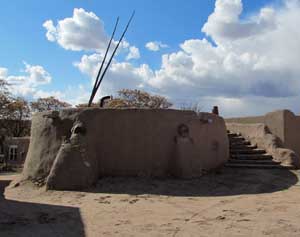
Nambé Pueblo

The main kiva at Nambé Pueblo
The area that is now Nambé Pueblo was likely settled in the 1300s CE after groups of Ancestral Tewa had made their way east from the Mesa Verde area to the San Luis Valley. From there they journeyed down the east side of the Rio Grande to the Nambé River basin. There, they traveled up streambeds and into the high country to settle, coming down to the lower Nambé River valley only in the summer to grow their crops. Eventually, they felt safe enough to stay in the lower valley year round and abandoned the higher mountain villages.
By 1600 CE, Nambé was a primary economic, cultural and religious center in the Tewa Basin (the valley of the Rio Grande between the Rio Grande Gorge and White Rock Gorge). Nambé's relative "wealth" attracted a large Spanish presence and the nature of that presence caused the Nambé people to join wholeheartedly in the Pueblo Revolt of 1680.
The Spanish returned in 1692. Their rule was a bit less harsh, however, the Spanish brought the first horses (and other domesticated livestock) into the New World and as the number of Spanish settlers increased, so did the number of wild horses. More horses brought more raids from the Utes, Navajos, Apaches and Comanches as they came looking for whatever they could carry away. The worst of the raiders, the Comanches, were finally subdued by Governor Juan Bautista de Anza in 1776 but by then, the impact of European diseases was overwhelming the people of Nambé. A smallpox epidemic in the late 1820s virtually ended the pueblo.
The Nambé pottery tradition is similar to that of Taos and Picuris in their use of micaceous clay slips but, like other villages in Tewa Basin, Nambé potters also used to produce white-on-red and all-black products, too. When Lonnie Vigil began producing his micaceous clay masterpieces in the 1990s, he almost single-handedly jump-started the revival of pottery making at Nambé.
100 West San Francisco Street, Santa Fe, New Mexico 87501
(505) 986-1234 - www.andreafisherpottery.com - All Rights Reserved
